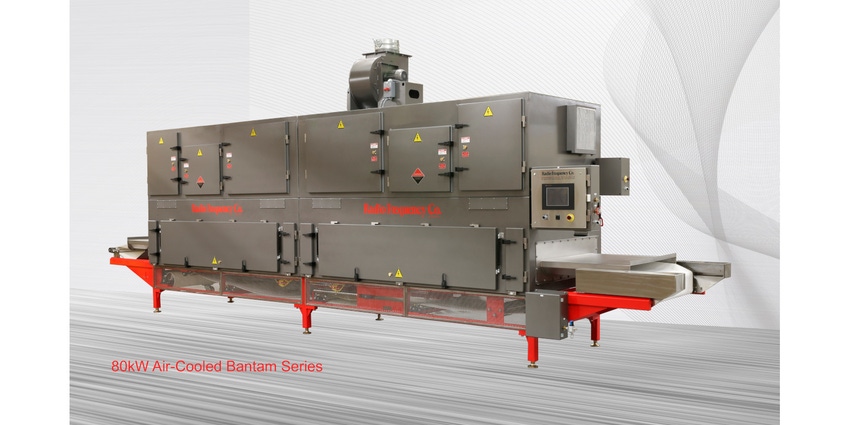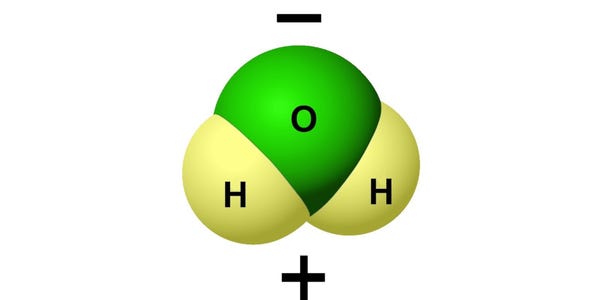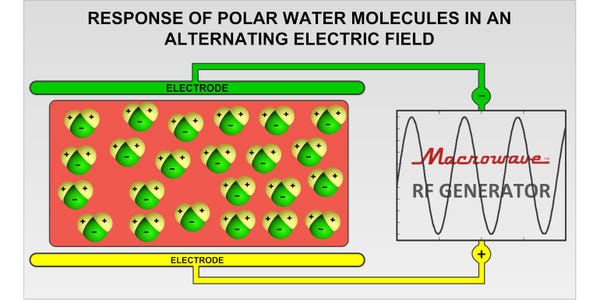Solving Challenging Drying Applications with RF Technology
This article discusses RF technology’s capabilities and how it could be a solution for those challenging drying applications.
December 3, 2020

Lisa A. Mitchell, marketing manager, Radio Frequency Co.
Simply put, RF technology rapidly heats and dries materials typically more uniformly and energy efficiently than other traditional methods. This technology isn't new to the marketplace, but many manufacturers remain unfamiliar with its unique possibilities for difficult drying applications. This article discusses RF technology’s capabilities and how it could be a solution for those challenging drying applications.
First developed in the 1940s, RF heating-drying technology has been used in numerous and varied production processes for more than 70 years for various applications including:
* post-bake drying for improved shelf-life and quality; it can also increase oven productivity by 35%
* pasteurization of low-moisture, low-water activity foods and ingredients to comply with FSMA
* drying of ceramic greenware (prior to firing); textile yarns, fabrics, and garments; fiberglass yarn and chopped strand; and water-based coatings, inks, and adhesives on webs in paper manufacturing and converting; hydrophilic foams and filter cakes
* drying and moisture leveling of bulk materials and webs, sheets, and boards
* preheating of thermoset sheet molding compounds (prior to molding)
* specialty cellular ceramic structure, such as extruded automotive catalytic converter substrates, an important application due to increased worldwide legislation regarding automobile manufacturer’s use of them. RF technology as a pre-kilning step that eliminates expensive part rejects for the manufacturer.
The Federal Communications Commission (FCC) has a list of allowable frequencies called the Industrial, Scientific, and Medical (ISM) frequencies for RF equipment manufacturers. RF systems operating at the ISM allowable frequency of 40.68 megahertz offer the most controllable power output with far fewer problems. 40-megahertz drying systems operate at voltages 20 to 40% lower than a system running at 13 to 27 megahertz, and because lower voltages mean fewer issues with arcing, there is less chance of damaging the material being dried. By comparison, RF dryers operating at lower frequencies of 13 to 27 megahertz require voltages 20 to 60% greater to be applied to the material, increasing the risk of arcing.
RF technology’s niche in the market is with drying low-moisture materials where other, more familiar drying methods, are ineffective, costly, or affect quality when removing those last small percentages of water. Conventional heating-drying methods such as convection, vacuum, freeze, or spray drying, have their advantages, but RF is often found to be the better solution because RF energy can be focused just on the moisture needing to be dried by acting on the water molecules within the material as depicted here:

Simply put, water is a polar molecule because of the orientation of the oxygen and hydrogen atoms; a water molecule has a positive and negative side, as shown in Figure 1. It’s this unique structure of the polar water molecule (H2O) that’s the basis for water’s thermal response when subjected to an alternating RF energy field.

When water molecules are subjected to an alternating RF field, the water molecules continuously reorient themselves, as show in Figure 2. Material conveyed between the RF applicator electrode plates is subjected to the alternating field as the current of each plate is alternated between positive and negative at a frequency of 40.68 megahertz. This translates to an alternating field of 40.68 million times per second. Subsequently the water molecule is forced to reorient themselves at 40.68 million times a second generating heat and evaporating the water in situ. Unlike traditional microwave systems, which have only a few centimeters depth of penetration, the heating in an alternating RF electric field is both very controllable and uniform throughout the entire material being dried.
The way energy is regulated in RF systems is via the output power control. In high-power RF systems, the source (the RF generator) and the load (the material) are part of the same circuit, meaning the system only powers up when material is present in the applicator between the electrode plates. Water molecules within the load have the electrical capacitive, or conductive, value required to tune or align the circuit for optimal drying efficiencies. This makes the RF drier technology energy efficient.
Simply put, the calculation for a drying application is 1 kilowatt of power is required to dry 1 kg of water per hour. Conventional drying methods require the water to move to the surface by capillary action, a progressive/slower heating reaction. With certain materials this can cause the undesirable migration of solids in suspension. And since only the material’s water molecules are targeted in RF heating-drying, only the energy needed to heat the water molecules is required to dry just the percentage of excess water and no more. Once the material being dried in an RF system has the desired moisture content, it draws no power from the system, so there isn’t the risk of over-drying the material.
Evaluating an RF Heating-Drying Application
It’s simple to evaluate an RF heating-drying application: it begins at the manufacturer’s laboratory with a feasibility study using the customer’s sample material so they can evaluate the processes’ effectiveness. Receptivity, dwell time, and power requirements are determined. With that a cost analysis of a potential system can be generated, as well as a preliminary drawing giving the equipment’s footprint, detailing its power requirements and ancillary system requirements - like compressed air, so the customer can evaluate the technology’s ROI. A complete thermal analysis is recorded using fiber-optic temperature probes imbedded into the sample material while being exposed to the RF energy. At the same time, other data such as power output, ambient conditions, and exposure time are recorded so that all scale-up factors are available. With this information, a manufacturer can determine if purchasing an RF dryer is the right move for your process application. Simply put.
Lisa A. Mitchell is the marketing manager for Radio Frequency Co. (Millis, MA). She has nearly 30 years of experience working for capital equipment manufacturers and has been with Radio Frequency Co. for more than 17 years. For more information, call 508-376-9555 or visit radiofrequency.com.
You May Also Like


